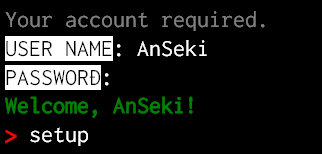| lib | ||
| .gitignore | ||
| cl_01.png | ||
| LICENSE-MIT | ||
| package.json | ||
| README.md | ||
readlineSync
Synchronous Readline for interactively running.
The interface is used with process.stdin and process.stdout in order to accept user input.
Example
var readlineSync = require('readline-sync');
var answer = readlineSync.question('What is your favorite food? :');
console.log('Oh, so your favorite food is ' + answer);
Installation
npm install -g readline-sync
Usage
setPrompt
readlineSync.setPrompt(prompt)
Sets the prompt, for example when you run node on the command line, you see > , which is node's prompt.
prompt
line = readlineSync.prompt([options])
Readies readline for input from the user, putting the current setPrompt options on a new line, giving the user a new spot to write.
If {noEchoBack: true} is specified to options, echo back is avoided. It is used to hide the password which is typed by user on screen. See Note for security.
question
line = readlineSync.question(query[, options])
Displays the query to the user, and then returns the user's response after it has been typed.
If {noEchoBack: true} is specified to options, echo back is avoided. It is used to hide the password which is typed by user on screen. See Note for security.
setEncoding
readlineSync.setEncoding(encoding)
Set the encoding method of input (user's response) and output (prompt). Defaults to 'utf8'.
setPrint
readlineSync.setPrint(funcPrint)
The specified Function is called when any texts are outputed (prompt and question). Two arguments the text which is outputed and encoding are passed. Defaults to undefined.
For example, this is used to pass plain texts to Logger, when prompt texts are colored.
var readlineSync = require('readline-sync');
user, pw, cmd;
require('colors');
readlineSync.setPrint(function(display, encoding) {
logger.log(display.stripColors); // remove control characters
});
console.log('Your account required.'.grey);
user = readlineSync.question('USER NAME'.white.inverse + ': ');
pw = readlineSync.question('PASSWORD'.white.inverse + ': ', {noEchoBack: true});
// Authorization ...
console.log(('Welcome, ' + user + '!').green.bold);
readlineSync.setPrompt('> '.bold.red);
cmd = readlineSync.prompt();
Note
- The your Node and OS may not support interactively reading from stdin. The stdin interfaces are different by platforms.
If in those platforms, an error is thrown.
try {
answer = readlineSync.question('What is your favorite food? :');
} catch (e) {
console.error(e);
process.exit(1);
}
- If
options.noEchoBackis used, the text that input by user is saved to temporary file (e.g./tmp/readline-sync.stdout). This file is removed immediately after reading is done, but you have to be careful about it because this text is plain. Removing the file might fail, or the file might be peeped before it is removed.
Release History
- 2014-07-12 v0.4.0 Add
options.noEchoBack. - 2014-07-12 v0.3.0 Add
setPrint(). - 2014-06-27 v0.2.3 Add alternative reading via shell on the environment which don't support interactively reading.
- 2013-12-18 v0.2.2 Error handle for the environment which don't support interactively reading from stdin.
- 2013-08-30 v0.2.0 Rewrite exporting methods.
- 2013-08-29 v0.1.0 Initial release.
